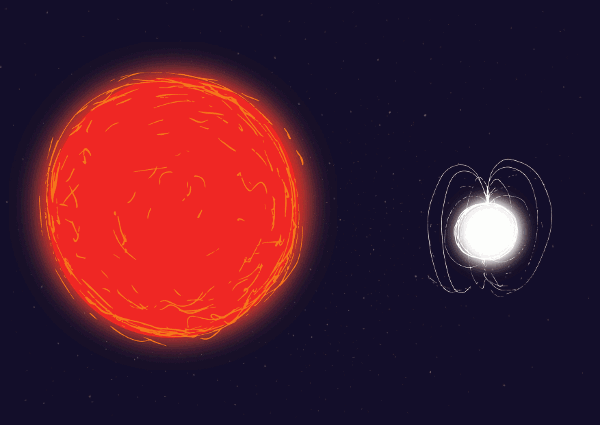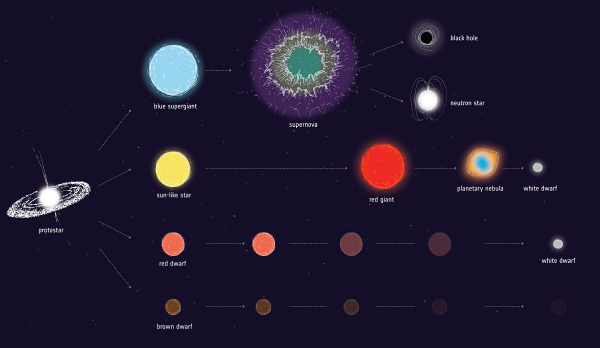Donor star breathes life into zombie companion
5 March 2018
ESA's INTEGRAL space observatory has witnessed a rare event: the moment that winds emitted by a swollen red giant star revived its slow-spinning companion, the core of a dead star, bringing it back to life in a flash of X-rays. |
| Red giant and neutron star interaction. Credit: ESA |
The X-ray flare was first detected by INTEGRAL on 13 August 2017 from an unknown source in the direction of the crowded centre of our Milky Way. The sudden detection triggered a slew of follow-up observations in the following weeks to pin down the culprit.
The observations revealed a strongly magnetised and slowly rotating neutron star that had likely just begun to feed on material from a neighbouring red giant star.
Stars the mass of our Sun, and up to eight times more massive, evolve into red giants towards the end of their lives. Their outer layers puff up and expand millions of kilometres, their dusty, gassy shells blown away from the central star in relatively slow winds up to few hundreds of km/s.
Even larger stars, up to 25–30 times more massive than the Sun, race through their fuel and explode in a supernova, sometimes leaving behind a spinning stellar corpse with a strong magnetic field, known as a neutron star. This tiny core packs the mass of nearly one and half Suns into a sphere only 10 km across, making them some of the densest celestial objects known.
 |
| Stellar evolution. Credit: ESA |
It is not uncommon to find stars paired together, but the new system of a neutron star and red giant is a particularly rare breed known as a 'symbiotic X-ray binary', with no more than 10 known.
"INTEGRAL caught a unique moment in the birth of a rare binary system," says Enrico Bozzo from University of Geneva and lead author of the paper that describes the discovery. "The red giant released a sufficiently dense slow wind to feed its neutron star companion, giving rise to high-energy emission from the dead stellar core for the first time."
The pairing is certainly peculiar. ESA's XMM-Newton and NASA's NuSTAR space telescopes showed that the neutron star spins almost every two hours – very slow compared with other neutron stars, which can spin up to many times per second. Then, the first measurement of the magnetic field of such a neutron star revealed it to be surprisingly strong.
A strong magnetic field typically points to a young neutron star – the magnetic field is thought to fade over time – while a red giant is much older, making it a bizarre couple to have grown up together.
"These objects are puzzling," says Enrico. "It might be that either the neutron star magnetic field does not decay substantially with time after all, or the neutron star actually formed later in the history of the binary system. That would mean it collapsed from a white dwarf into a neutron star as a result of feeding off the red giant over a long time, rather than becoming a neutron star as a result of a more traditional supernova explosion of a short-lived massive star."
With a young neutron star and an old red giant, at some point the winds travelling from the puffed-up giant will begin to rain on to the smaller star, slowing its spin and emitting X-rays.
"We haven't seen this object before in the past 15 years of our observations with INTEGRAL, so we believe we saw the X-rays turning on for the first time," says Erik Kuulkers, ESA's INTEGRAL project scientist. "We'll continue to watch how it behaves in case it is just a long 'burp' of winds, but so far we haven't seen any significant changes."
Notes for Editors
"IGR J17329-2731: The birth of a symbiotic X-ray binary," by E. Bozzo et al. is accepted for publication in Astronomy & Astrophysics.
The rapid response of the follow-up observations was enabled by the SmartNet community. This included important contributions from ESA's XMM-Newton and NASA’s NuSTARand Swift space telescopes, and the ground-based Southern Astrophysical Research Telescope, Faulkes Telescopes North and South and the Las Cumbres Observatory.
For further information, please contact:
Enrico Bozzo
University of Geneva, Switzerland
Email: enrico.bozzo![]() unige.ch
unige.ch
Erik Kuulkers
ESA INTEGRAL Project Scientist
Email: erik.kuulkers![]() esa.int
esa.int
Markus Bauer
ESA Science Communication Officer
Tel: +31 71 565 6799
Mob: +31 61 594 3 954
Email: markus.bauer![]() esa.int
esa.int


